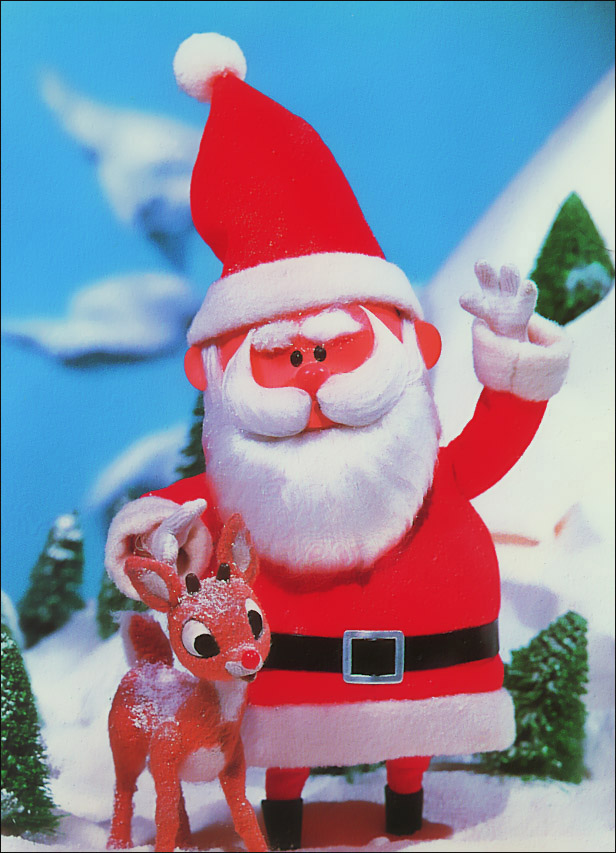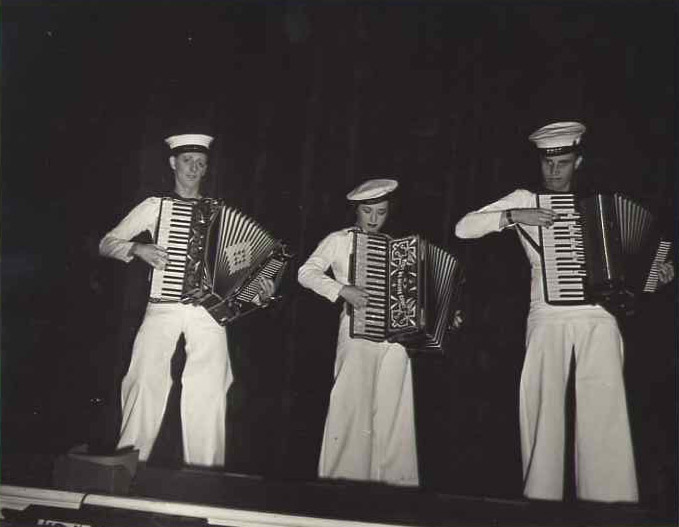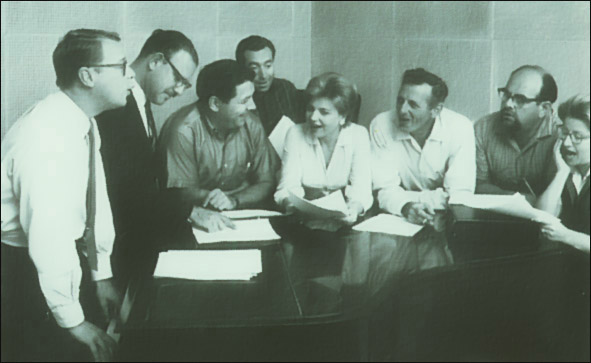Billie
Mae Richards
The Voice of Rudolph The
Red-Nosed Reindeer

Page Two
(to return to
Page One, click here)
With the commencement of WWII, Billie decided to separate herself from her unchosen profession for a time, by enrolling in the military. Her respite, however, was brief. "I joined the Navy, and was still in basic training when an officer came up to me. I thought I'd done something wrong, but all he said was that he wanted me to audition for the Navy show and to bring my accordion." She auditioned as ordered, performing unusual numbers on her accordion such as The Grand Canyon Suite and Dark Eyes. "I looked into the audience, and there was my piano/accordion instructor, and a conductor who'd been at a radio station I'd been to as a child. They were the officers who had called for my audition."
The ensuing
show, called Meet The Navy, was a huge production which played
throughout Canada during the war years. Billie's talents contributed to the
scope and entertainment value of the show. "This wasn't a troop show, but a show
designed to make money, to boost the morale of the civilians at home as well as
the troops. We went all over Canada, from Goose Bay to Labrador. When the show
finished Canada, we went overseas, all over Britain, as well as Paris and
Brussels. When the war was over, we gave a command performance in London and
that led to the movie which was filmed at Elstree Studios." The 1946 film,
directed by Alfred Travers, added a light romantic subplot to the show's
variety-act format, and featured Billie (billed as 'Mae Richards') as a dancer.
war years. Billie's talents contributed to the
scope and entertainment value of the show. "This wasn't a troop show, but a show
designed to make money, to boost the morale of the civilians at home as well as
the troops. We went all over Canada, from Goose Bay to Labrador. When the show
finished Canada, we went overseas, all over Britain, as well as Paris and
Brussels. When the war was over, we gave a command performance in London and
that led to the movie which was filmed at Elstree Studios." The 1946 film,
directed by Alfred Travers, added a light romantic subplot to the show's
variety-act format, and featured Billie (billed as 'Mae Richards') as a dancer.
Having become a petty officer in the Navy, with professional credentials in three different entertainment mediums by the age of twenty-five, it became necessary for Billie to concentrate in earnest on the direction of her future career. "When I came home, I took my credits for having served in the military, and enrolled in Lorne Greene's Academy Of Radio Arts in Toronto. I planned to do what I'd always done, which was act, but I didn't know what. I didn't have a technique. There's a whole technique to radio acting. It's very different than musical theater. You don't move your arms around, you don't play it as broadly. It was very educational for me, and after I graduated I went right into twenty-five years of acting on the CBC. That was the next big phase of my career."
It was also the period in which she established her trademark role, that of a little boy. "I got that out of the Academy," she recalls. "They heard my voice, and every time they had a boy to cast, they said I'd be it. I just found myself falling right into it. I never did any girl characters from then on. All my parts were boys." She laughs. "I don't think I was given the name Billie for nothing. My father had wanted a boy."
Once this type of character had become established as her specialty, the CBC began to bill her as Billy Richards, with no further publicity for who she was. Her performances were so believable that no one caught on. In spite of her acclaim, this condition persists today. "Kids won't believe it when my grandchildren tell them that their grandmother is really Rudolph," she chuckles. "But I can prove itó'Hermey's my friend. He wants to be a dentist. We're misfits together.' As soon as they hear that, they'll say 'You really ARE Rudolph!' They can always recognize the voice."
For many years, Billie played a variety of children on the radio, often doing several shows a day. Her most famous part was The Kid in the well-remembered W.O. Mitchell series "Jake And The Kid," which has endured into the present in both television and book formats. The radio show ran for six years in the 1950s, and was a keystone portrayal which helped to define Billie's technique. "The Kid was a farm boy, and very sincere. W.O. Mitchell was a fabulous writer in Canada, and he wrote right into my house. Once he heard me, he said I was it. He needed someone who could be a boy, but put an adult mind with it, because a child can't always tell what he's going through, and express that vocally." In this manner, combining the personality of a child with the perspective of an adult, Billie established her reputation as the former child actor who had become one of the foremost actors of children. "All the little boy roles I've ever done were very real, no matter how distorted the story might have been. It's like comedy, for instance. You don't go in to be funny, you just say the lines properly and in the situation, and it will be funny. W.O. Mitchell would put things into "Jake And The Kid" which I couldn't react to, because an 11-year old boy wouldn't get it. I let it go over my head."
The range of her radio characterizations became wide over the years (in such shows as This Was My Father, What Makes Sammy Run, Colored Buttons, My Friend Ned, and Echo Of No Return) but all of them remained within the boundaries of childhood. "I could play roles from age five to the voice-changing years. Sometimes I would start by playing the older brother of one of the actual boy actors on a series, and after he had aged, I would turn around and begin playing the younger brother's role. I did so many parts on radio, so many difficult things, and that was all I needed to do cartoons. Because it's radio."
Rudolph
The Red-Nosed Reindeer was a 1964 project for the Rankin-Bass Videocraft
studios in New York,
 which had acquired the rights to the 1939 Robert L. May
book and the popular 1949 song by May's brother-in-law Johnny Marks. The entire
cast for the production was culled from Canadian radio talent. "The cartoon
people came to Canada because our radio didn't die when TV came around, like it
did in the USA. And animation (voiceover work) is just radio. I'd worked for so
long, they knew the way I approached things. They asked me to do the part, and I
said 'Oh. Okay.' It was a one-shot deal, and I didn't ask a lot of questions. We
did the voiceover work in Toronto, and the songs in New York. It felt completely
natural." (Picture shows Billie on far right)
which had acquired the rights to the 1939 Robert L. May
book and the popular 1949 song by May's brother-in-law Johnny Marks. The entire
cast for the production was culled from Canadian radio talent. "The cartoon
people came to Canada because our radio didn't die when TV came around, like it
did in the USA. And animation (voiceover work) is just radio. I'd worked for so
long, they knew the way I approached things. They asked me to do the part, and I
said 'Oh. Okay.' It was a one-shot deal, and I didn't ask a lot of questions. We
did the voiceover work in Toronto, and the songs in New York. It felt completely
natural." (Picture shows Billie on far right)
This "naturalness" is reflected in her performance, and continued to be her trademark as she became a fixture in animation just as she had been in radio. "I never did 'voice' characters," she says, offering a squeaky little voice as an example. "I could do them for fun, but I like to find something true in the character. If it was Care Bears or whatever they were, to me they had to stand out. I loved doing Rudolph because it's real. There's a reality about the character. You really know that whatever he's doing, he's doing it for a reason. That's why it's been so popular. That and Burl Ives, for heaven's sake."